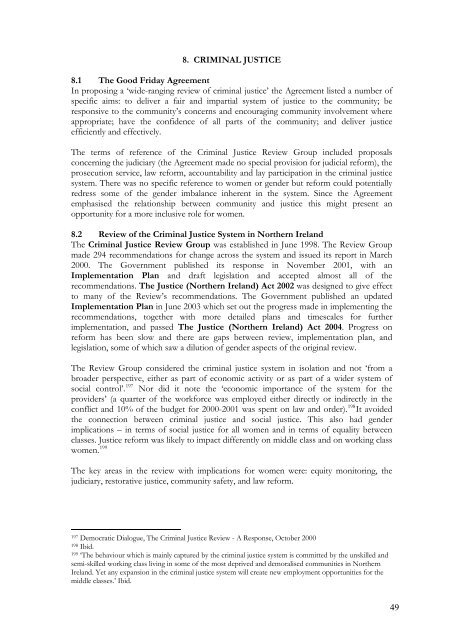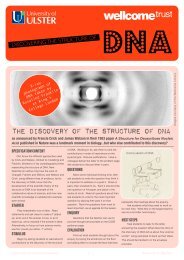Agreement Reached in the Multi-Party Negotiations - Transitional ...
Agreement Reached in the Multi-Party Negotiations - Transitional ...
Agreement Reached in the Multi-Party Negotiations - Transitional ...
You also want an ePaper? Increase the reach of your titles
YUMPU automatically turns print PDFs into web optimized ePapers that Google loves.
8. CRIMINAL JUSTICE<br />
8.1 The Good Friday <strong>Agreement</strong><br />
In propos<strong>in</strong>g a ‘wide-rang<strong>in</strong>g review of crim<strong>in</strong>al justice’ <strong>the</strong> <strong>Agreement</strong> listed a number of<br />
specific aims: to deliver a fair and impartial system of justice to <strong>the</strong> community; be<br />
responsive to <strong>the</strong> community’s concerns and encourag<strong>in</strong>g community <strong>in</strong>volvement where<br />
appropriate; have <strong>the</strong> confidence of all parts of <strong>the</strong> community; and deliver justice<br />
efficiently and effectively.<br />
The terms of reference of <strong>the</strong> Crim<strong>in</strong>al Justice Review Group <strong>in</strong>cluded proposals<br />
concern<strong>in</strong>g <strong>the</strong> judiciary (<strong>the</strong> <strong>Agreement</strong> made no special provision for judicial reform), <strong>the</strong><br />
prosecution service, law reform, accountability and lay participation <strong>in</strong> <strong>the</strong> crim<strong>in</strong>al justice<br />
system. There was no specific reference to women or gender but reform could potentially<br />
redress some of <strong>the</strong> gender imbalance <strong>in</strong>herent <strong>in</strong> <strong>the</strong> system. S<strong>in</strong>ce <strong>the</strong> <strong>Agreement</strong><br />
emphasised <strong>the</strong> relationship between community and justice this might present an<br />
opportunity for a more <strong>in</strong>clusive role for women.<br />
8.2 Review of <strong>the</strong> Crim<strong>in</strong>al Justice System <strong>in</strong> Nor<strong>the</strong>rn Ireland<br />
The Crim<strong>in</strong>al Justice Review Group was established <strong>in</strong> June 1998. The Review Group<br />
made 294 recommendations for change across <strong>the</strong> system and issued its report <strong>in</strong> March<br />
2000. The Government published its response <strong>in</strong> November 2001, with an<br />
Implementation Plan and draft legislation and accepted almost all of <strong>the</strong><br />
recommendations. The Justice (Nor<strong>the</strong>rn Ireland) Act 2002 was designed to give effect<br />
to many of <strong>the</strong> Review’s recommendations. The Government published an updated<br />
Implementation Plan <strong>in</strong> June 2003 which set out <strong>the</strong> progress made <strong>in</strong> implement<strong>in</strong>g <strong>the</strong><br />
recommendations, toge<strong>the</strong>r with more detailed plans and timescales for fur<strong>the</strong>r<br />
implementation, and passed The Justice (Nor<strong>the</strong>rn Ireland) Act 2004. Progress on<br />
reform has been slow and <strong>the</strong>re are gaps between review, implementation plan, and<br />
legislation, some of which saw a dilution of gender aspects of <strong>the</strong> orig<strong>in</strong>al review.<br />
The Review Group considered <strong>the</strong> crim<strong>in</strong>al justice system <strong>in</strong> isolation and not ‘from a<br />
broader perspective, ei<strong>the</strong>r as part of economic activity or as part of a wider system of<br />
social control’. 197 Nor did it note <strong>the</strong> ‘economic importance of <strong>the</strong> system for <strong>the</strong><br />
providers’ (a quarter of <strong>the</strong> workforce was employed ei<strong>the</strong>r directly or <strong>in</strong>directly <strong>in</strong> <strong>the</strong><br />
conflict and 10% of <strong>the</strong> budget for 2000-2001 was spent on law and order). 198 It avoided<br />
<strong>the</strong> connection between crim<strong>in</strong>al justice and social justice. This also had gender<br />
implications – <strong>in</strong> terms of social justice for all women and <strong>in</strong> terms of equality between<br />
classes. Justice reform was likely to impact differently on middle class and on work<strong>in</strong>g class<br />
women. 199<br />
The key areas <strong>in</strong> <strong>the</strong> review with implications for women were: equity monitor<strong>in</strong>g, <strong>the</strong><br />
judiciary, restorative justice, community safety, and law reform.<br />
197 Democratic Dialogue, The Crim<strong>in</strong>al Justice Review - A Response, October 2000<br />
198 Ibid.<br />
199 ‘The behaviour which is ma<strong>in</strong>ly captured by <strong>the</strong> crim<strong>in</strong>al justice system is committed by <strong>the</strong> unskilled and<br />
semi-skilled work<strong>in</strong>g class liv<strong>in</strong>g <strong>in</strong> some of <strong>the</strong> most deprived and demoralised communities <strong>in</strong> Nor<strong>the</strong>rn<br />
Ireland. Yet any expansion <strong>in</strong> <strong>the</strong> crim<strong>in</strong>al justice system will create new employment opportunities for <strong>the</strong><br />
middle classes.’ Ibid.<br />
49
















